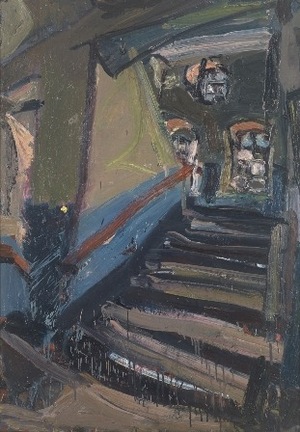IN MEMORIAM OF A.VAITKŪNAS. STAIRCASES. 1995 – 2001. 0
Aušra Barzdukaitė-Vaitkūnienė
www.kamane.lt, 2008 05 12
“Staircase”, 2000, canvas, oil, 96x70 cm
Arūnas did not paint such staircases that were created at nights in forlorn houses any more. “It would not be difficult to repeat myself but why should I do it?“ he asked. Nonetheless, there are some paintings in which the motif of staircases is evident. Such canvases were painted in the workshop. Some of them are of large format.
“Interior” painted in the workshop in 1992 is of 192x130 cm. Even though the canvas is abstract, with wild expression of colours, the primary motif which encouraged to create the painting has remained in it – it is so typical of Arūnas. Black stairs going nowhere rise in the flashes of red, blue and yellow colour.
Another painting created in 1995 “Stairs in the Dark” belongs to the period of abstract paintings of large format of Arūnas. According to the art critic Dr. Raminta Jurėnaitė, “by combining bright contrasting colours with achromatic colour parts, contrasts, he strengthens the expression of strokes even more.“
Arūnas spoke in 1996: “My vision of painting is pure expression. Expression in every point, stroke, line, colour, like an element uniting and mobilising the entirety of painting. The pictured motif does not have any meaning by itself, it only helps to reach internal tension, it serves like a tonometer of the painting process, as pure abstractions are often empty and decoratively beautiful only from the outside.“
“Stairs in the Dark“ is a painting that embodies the generalised experience of the “staircase period”. The colour structure of the canvas is interesting. Colours are more open, they contrast with each other creating tension on the surface layer of the painting. Still, they cover deeper layers – the ones in which dark, lush colours are hidden, like the patina of past time. New contrasts appear between the first layer of colours and the deeper one as if tension between the present and the past. Tension and strange deep space is created in this way.
The motif of rising stairs remains in the painting “Staircase with a Light Bulb” created in the same year. Spots of violet and green colours contrast in the canvas: according to Arūnas, “you perceive something more in daily life (green turns into violet)“. The dramatic turn is illuminated by a light bulb representing the sun in the staircase behind which the immeasurable space of blue cobalt reveals. Now this work is the property of Vilnius Art Museum.
In 2000 – 2001 Arūnas painted two works in the staircase of my workshop in Šančiai barracks. I remember he helped to carry works after an exhibition to the workshop then. While carrying them, he took longer and longer stops in the staircase. I came out to see where he disappeared. Arūnas stood and made sketches in a notebook. He asked for keys from my workshop the next day, took paints, the canvas and left to paint.
Staircases in Šančiai barracks are spacious and painted in blue colour; lines imitating carpets have remained there from the Soviet times. Arūnas succeeded to render this authentic atmosphere, the mood of barracks in two canvases well.
The painting “Composition with a Pawn” created in 2000 is like a sum of impressions that were captured by Arūnas in Šančiai barracks. The surface of the painting is carved with nervous blue strokes, it is drawing by the colour rather than painting as he wanted to render the idea rather than beautify the reality. The colouring is military blue and green, and the cadmium yellow peeps only in the far plan of the work. A large chess figure – a pawn – occupies almost the entire space of the painting in the right side of it.
What was meant by the painter – was it a conceptual creation of the painting granting the meaning of chess figures to barracks and soldiers? Or was it a response to art critics who searched for novelties in his works?
Arūnas: “I wanted to say something of great significance but I did not want to change means of expression. I am told not to do what has been done already; however, chess has been played already as well, but you do not have to create new rules of the game every time.“









